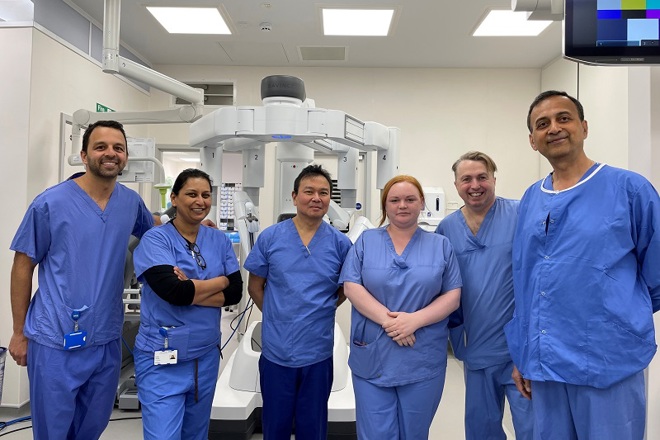News story posted May 2023
The Christie can now offer the most cutting-edge robotic surgery in the UK to cancer patients, after upgrading its existing surgical robotic technology with 2 state-of-the-art systems.
The Christie is a pioneer in robotic surgery – it was one of the first hospitals in the country to perform these operations in 2008. Since then, surgeons have carried out thousands of successful operations, improving patient experience, recovery and outcomes. The team carry out one of the highest volumes of robotic operations in the UK.
The Christie has now upgraded its technology, receiving 2 state-of-the-art Da Vinci Xi robots worth a total of £4m. It is the only hospital in the North West, and one of only a handful in the country, to have 2 and funding was provided by the NHS. In addition to significant patient benefits, upgrading to the latest technology reduces costs and pressure on the NHS by reducing the length of hospital stay.
The new robots are used for keyhole surgery. They have a wider range of movement and are more flexible than the previous model. This added manoeuvrability will allow surgeons at The Christie to work in multiple parts of the abdomen, increasing the number of different procedures that can be done robotically. The Trust offers this form of treatment to people with certain gynaecological (endometrial, cervical, ovarian), colorectal (bowel, appendiceal) and urological (prostate, advanced testicular) cancers, as well as retroperitoneal sarcoma (a very rare abdominal connective tissue cancer).
The Christie’s surgeons hope that the new more advanced technology will mean that more operations can be converted from an open approach to smaller keyhole surgeries. This means a much-reduced stay in hospital – from more than a week to 1 to 2 days – and an overall recovery at home in weeks rather than months.
The Christie is also receiving 2 new control consoles with each robotic system. This will allow 2 surgeons to pass control of the robot to each other with the click of a button, meaning that they can both operate on the same patient more easily than before. This is particularly useful when you have a complex operation involving multiple specialists, e.g. a colorectal and a urological surgeon. It will also make training the robotic surgeons of the future easier. The Christie is an accredited robotic training centre for gynaecological and urological procedures, with surgeons visiting from across the UK and beyond.

Miss Eva Myriokefalitaki, clinical director of surgery at The Christie, says: “This is an excellent opportunity for our robotic surgeons to be able to perform major complex surgery, including fertility preservation cancer treatments, in a less invasive way. The most obvious benefit is that they can get home to their families and day-to-day lives sooner. The use of robotic surgery means that patients who in the past wouldn’t have been suitable for surgery, and would have had limited options, can now be treated with curative intend. That means a prolonged life expectancy and a better quality of life.”
Jean Lloyd, a retired factory worker from north Wales, had robotic surgery to remove part of her bowel. “I always felt like I was in safe hands at The Christie, so when my surgeon told me that I was going to be having part of my surgery done by a robot, I wasn’t fazed at all,” said Jean. “Having a big operation is never easy, but I’m fully recovered now and am back to living a relatively normal life. I wouldn’t be here without my team at The Christie. I can’t thank them enough for what they’ve done for me.”
Mr Aziz Gulamhusein is a consultant urological and robotic surgeon at The Christie. He says: “The Christie has a very specialist surgery service. We operate on a multitude of both common and rare cancers, as well as advanced or recurring cancers sometimes only surgical managed at our centre. Combining our considerable expertise with this technology will allow us not only to use robots in more types of surgery but also to develop new and better ways of doing things. We were one of the first hospitals in the UK to get surgical robots back in 2008, so these new ones will help us build on that pioneering legacy.”
The new Da Vinci robots have been named by The Christie team Donatello and Raphael after taking inspiration from 2 other prominent Renaissance artists. The previous robots were called Mona and Lisa.
The Christie’s robotic surgeons are Mr Aziz Gulamhusein, Miss Bridget DeCruze, Mr Maurice Lau, Mr Jeremy Oates, Mr Vijay Ramani, Mr Chelliah Selvasekar, Mr Michael Smith, Miss Eva Myriokefalitaki and Mr Brett Winter-Roach. You can find out more about The Christie’s surgery service on our surgery webpages.
